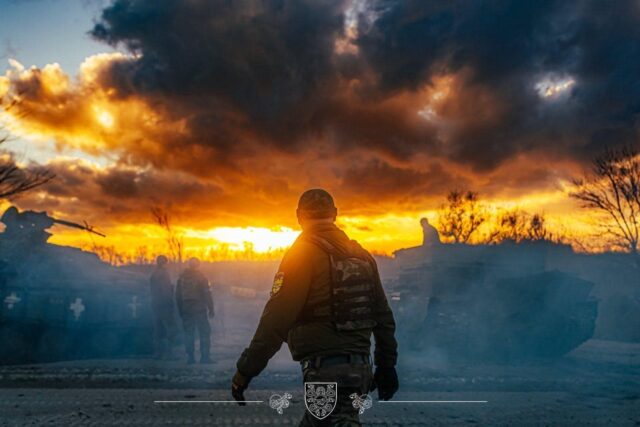
Peace Unattainable Without Victory in Ukraine
Publication: Eurasia Daily Monitor Volume: 20 Issue: 179
By:

The West’s inadequate arming of Ukraine predetermined costly failures for Kyiv’s counteroffensive. The effort to dislodge Russian forces from their entrenched positions in southeastern Ukraine has become a difficult endeavor both militarily and politically (Euromaidan Press, November 6). Kyiv felt obligated to meet unrealistic expectations and, in particular, to demonstrate that it deserved continuing Western support amid growing signs of fatigue and distraction. In this sense, Ukraine’s counteroffensive became “not only a military but also a political operation” (Dzerkalo Tyzhnia, November 5).
Rather than turning the war from positional to maneuver warfare as intended, some observers conclude that the Ukrainian counteroffensive seems to have reached a deadlock, thus prolonging the positional war. This is an interim outcome that need not be final. It has become a self-fulfilling prophecy, however, for proponents of a negotiated solution to the war premised on the existing frontlines.
Amid a cacophony of recommendations to “end the war,” three concepts stand out. Each is inspired by past models: informally “freezing” the conflict (post-Soviet model); officially drawing a demarcation line across Ukraine (Korea model); or guaranteeing a rump Ukraine’s security, possibly by the North Atlantic Treaty Organization (NATO), without prejudicing Kyiv’s right to regain its Russian-occupied territories in the future (West Germany model).
These three concepts imply trading Ukrainian land for a Russian hybrid “peace.” They presuppose partitioning Ukraine effectively without a treaty and even continuing to recognize the country’s territorial integrity, however ineffectual (Georgia post-2008 and Ukraine post-2014 model).
Frozen Conflict Model
Ukraine does not have the option to “freeze” the war unilaterally, nor to initiate a bilateral “freeze” with Russia. The Kremlin’s objectives in Ukraine are unlimited, amounting to the destruction of this state. Moscow continually reaffirms these objectives, along with suggestions to negotiate on this basis.
Major Ukrainian battlefield victories could hypothetically make Russia amenable to a temporary or local “freeze,” but any arrangement with Moscow would be hybrid by nature. Even during the lifetime of the Minsk “armistice” (September 2014–February 2022), Russia continuously fueled low-intensity warfare, punctuated by high-intensity phases, to pressure Kyiv and ultimately the West into political concessions. As NATO Secretary-General Jens Stoltenberg has again remarked, Ukraine cannot afford to stop fighting for its existence (Focus, November 17). Following the stalling of Ukraine’s counteroffensive, President Volodymyr Zelenskyy has found it necessary to say “never again” about Minsk-type arrangements (President.gov.ua, November 5, 10).
Korea Model
Analogies between the Korean armistice and any conceivable armistice in Ukraine are untenable (Valdaiclub.com, October 2023). Ukraine is an independent state, its territorial integrity and borders enjoying full international recognition. The West’s declared rationale for supporting Ukraine in this war is the inadmissibility of territorial conquests and border changes through force by Russia. Ceding Ukrainian territories to Russia under the guise of an armistice-in-place would nullify that rationale. The Korean peninsula, however, had been a Japanese possession, was divided into occupation zones at the end of World War II, and practically divided into two states before the outbreak of the Korean War. The 1953 armistice sealed that pre-war situation.
South Korea opposed the partition. US military commanders co-signed it, alongside China and North Korea, ending the hostilities. An armistice in Ukraine, however, would be inconceivable without Kyiv’s free consent. And Washington has no intention to become a party, let alone a guarantor, to an armistice in Ukraine.
North Korea continued to exist as a state, not being annexed by a nearby great power. Ukraine’s relinquished eastern territories, however, would not become a state but merely parts of Russia (see EDM, June 5).
US Admiral (ret.) and former Supreme Allied Commander Europe James Stavridis (among others) considers applying the Korea model in Ukraine. (Stavridis had previously proposed a freedom-of-navigation operation in the Black Sea; see EDM, July 31.) In the Korea model, however, Washington guarantees South Korea’s security by treaty, with powerful forces based in the country and naval forces stationed in that theater. The United States and NATO do not offer anything comparable to Ukraine, whether on land or in the Black Sea, to mitigate the consequences of ceding Ukrainian territories to Russia.
West Germany Model
Accepting a rump Ukraine into NATO is an idea that surfaces from time to time. Most recently, it came from the alliance’s former Secretary-General Anders Fogh Rasmussen. An aide to the incumbent Stoltenberg had launched such a proposal in August, generating much controversy (Ukrinform, August 14-17). This idea broadly follows the model of West Germany’s accession to NATO in 1955. The allies explicitly excluded the Soviet occupation zone from the purview of NATO guarantees, but they fully recognized Germany’s right to become reunited in the future. A solution of this type would supposedly enable a neo-containment of Russia along the frontlines in Ukraine, akin to the containment along the “central front” in Germany.
This analogy is amiss, however. Germany had been partitioned as a retribution measure, whereas Ukraine is a victim of aggression, necessitating not retribution but a remedial settlement. East Germany was nominally a state in its own right, neither annexed to the Soviet Union nor de-nationalized. Hence, the two German states could ultimately reunify. By contrast, Ukraine’s Russian-occupied territories have been directly annexed to Russia and are being de-Ukrainianized and Russified. Furthermore, the United States and other NATO powers maintained a large military presence in West Germany, whereas NATO and Washington avoid any intentions to put boots on the ground in Ukraine (see EDM, June 5).
Past models of managing conflicts with Russia are not applicable to the ongoing war in Ukraine. Engaging in any negotiations with Moscow so long as Russian forces occupy parts of Ukraine would be a self-defeating proposition. Defeating Russia on the battlefield in Ukraine is the only available means to avoid another protracted conflict with disruptive ripple effects throughout Europe’s security, economic, and political order.



